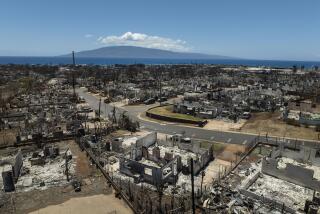Abandoned Military Houses Home to Homeless Families : Screening: U.S. has approved applications from 42 groups to provide housing for about 7,000 people a year nationwide. Applicants are asked whether they take drugs, go out drinking, if they practice birth control.
- Share via
DENVER — Natally Gary stood in the cozy living room of her duplex on a former military base and rattled off her history.
* Left home at 14 to escape her father’s abuse.
* Lost her parents in a murder-suicide four year ago.
* Single mother of five children, ages 4 and younger.
* Part-time cook who earns $330 in a busy two weeks, $190 if it’s slow.
Now, at 21, she sees in her tiny living room a chance for a new start.
“It’s been very hard for me,” she said, tears in her eyes. “I have a chance to go to school and better myself and I want to.”
Gary is among the first people to benefit from a federal law giving the homeless a shot at surplus government homes on closed military bases. She and her children moved into their new home at the former Lowry Air Force Base in early December after years of living in shelters or with friends and relatives.
As of Oct. 1, the government had approved applications from 42 groups that would provide housing for about 7,000 people a year nationwide, said Laura Weir, policy director of the National Law Center on Homelessness and Poverty, based in Washington, D.C.
In some states, homeless families already are living near bases. The program at the Lowry base, which closed Oct. 1, is apparently the first involving on-base units.
The Lowry families will pay reduced rent--generally about 30% of their monthly income--for two years.
Gary will pay $235 a month for her four-bedroom, two-bathroom duplex; similar units in the area cost about $800 a month.
Applicants are screened to make sure they’re trying to change their lives, said John Parvensky, director of the Colorado Coalition for the Homeless, which is helping to run the program.
They’re asked such questions as whether they take drugs, go out drinking and whether they practice birth control.
In Denver’s metropolitan area of about 2 million people, more than 1,300 are homeless on a given night.
But it took a long, bitter fight before the Air Force approved the Lowry program.
Thousands of property owners around the base opposed the plan, afraid that it would cause crime rates to rise, property values to decline and neighborhoods to deteriorate.
Military officials said the battle was one of the most contentious in the nation, partly because the 57-year-old base is in the middle of the metropolitan area and in a mostly residential area.
The dispute was resolved earlier this year when both sides agreed to set aside 86 of the base’s approximately 800 housing units for the homeless, down from nearly 200 sought by homeless advocates.
Other homeless advocates could face even more difficult battles. The federal law was revised to give control of surplus base housing to local redevelopment authorities instead of the federal government. That means neighborhood groups could wield more influence.
But at a news conference earlier this month, hostilities were set aside as representatives of some Lowry-area homeowner groups welcomed families moving into the duplexes.
“We think the integration will help the families who have been homeless by providing positive role models,” Parvensky said.
Gary sees brighter days ahead. She hopes to be an emergency medical technician and, eventually, a pharmacist.
“I don’t give up. When my parents passed away, I didn’t give up,” she said. “I’ll make it. I’ve made it this far.”
More to Read
Sign up for Essential California
The most important California stories and recommendations in your inbox every morning.
You may occasionally receive promotional content from the Los Angeles Times.










